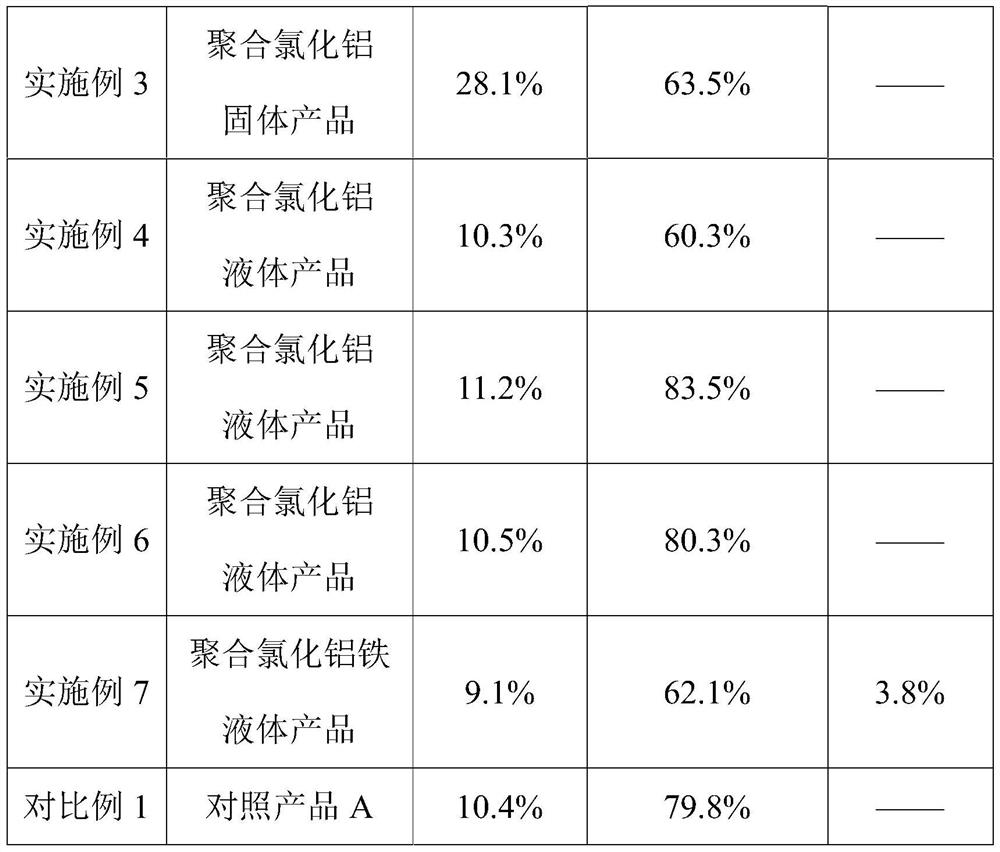A kind of treatment method of sodium tetrachloroaluminate solid slag
A technology of sodium tetrachloroaluminate and a treatment method, applied in the field of inorganic chemistry, can solve the problems of increased treatment cost, complex process, high energy consumption, and achieve the effects of no cross-contamination, simple process flow, and low equipment investment
- Summary
- Abstract
- Description
- Claims
- Application Information
AI Technical Summary
Problems solved by technology
Method used
Image
Examples
Embodiment 1
[0066] This embodiment provides a treatment method for sodium tetrachloroaluminate solid slag, which is derived from phosphorus trichloride, methyl chloride, aluminum trichloride, aluminum powder and sodium chloride, etc. In the production process of synthesizing diethyl methylphosphonite from raw materials, the content of sodium tetrachloroaluminate in the solid slag is 95%, and the treatment method comprises the following steps:
[0067] (1) Mix 100 g of solid residue with a sodium tetrachloroaluminate content of 95% and 300 g of water, dissociate at 80° C. for 1.5 h, add 5 g of oxidant sodium chlorate, and oxidize at 90° C. for 1 h;
[0068] (2) Add 40 g of sodium hydroxide solid with a content of 96% to the dissociation solution obtained in step (1), and polymerize at 80° C. for 1 h;
[0069] (3) The polymerization reaction solution obtained in step (2) was subjected to atmospheric concentration crystallization and solid-liquid separation at an end point temperature of 114...
Embodiment 2
[0073] This embodiment provides a treatment method for sodium tetrachloroaluminate solid slag, which is the same as in Example 1, and the treatment method includes the following steps:
[0074] (1) Mix 100 g of solid residue with a sodium tetrachloroaluminate content of 95% and 500 g of water, dissociate at 90° C. for 1 hour, add 5 g of oxidant sodium chlorate, and oxidize at 90° C. for 1 hour;
[0075] (2) Add 40 g of sodium hydroxide solid with a content of 96% to the dissociation solution obtained in step (1), and polymerize at 95° C. for 1 h;
[0076](3) The polymerization reaction solution obtained in step (2) was subjected to atmospheric concentration crystallization and solid-liquid separation at an end point temperature of 114° C. to obtain 120 g of sodium chloride solid and 170 g of concentrated mother liquor;
[0077] Among them, 120 g of sodium chloride solid is washed with 100 g of water, and then dried to obtain 80 g of sodium chloride product, which can be reused...
Embodiment 3
[0080] This embodiment provides a treatment method for sodium tetrachloroaluminate solid slag, which is the same as in Example 1, and the treatment method includes the following steps:
[0081] (1) Mix 100 g of solid residue with a sodium tetrachloroaluminate content of 95% and 400 g of water, dissociate at 60°C for 3 hours, add 50 g of oxidant hydrogen peroxide, and oxidize at 60°C for 1 hour;
[0082] (2) Add 100 g of sodium hydroxide solution with a content of 40% to the dissociation solution obtained in step (1), and polymerize at 70° C. for 2 h;
[0083] (3) The polymerization reaction solution obtained in step (2) was subjected to atmospheric concentration crystallization and solid-liquid separation at an end point temperature of 114° C. to obtain 120 g of sodium chloride solid and 170 g of concentrated mother liquor;
[0084] Among them, 120 g of sodium chloride solid is washed with 100 g of water, and then dried to obtain 80 g of sodium chloride product, which can be r...
PUM
 Login to View More
Login to View More Abstract
Description
Claims
Application Information
 Login to View More
Login to View More - R&D
- Intellectual Property
- Life Sciences
- Materials
- Tech Scout
- Unparalleled Data Quality
- Higher Quality Content
- 60% Fewer Hallucinations
Browse by: Latest US Patents, China's latest patents, Technical Efficacy Thesaurus, Application Domain, Technology Topic, Popular Technical Reports.
© 2025 PatSnap. All rights reserved.Legal|Privacy policy|Modern Slavery Act Transparency Statement|Sitemap|About US| Contact US: help@patsnap.com



